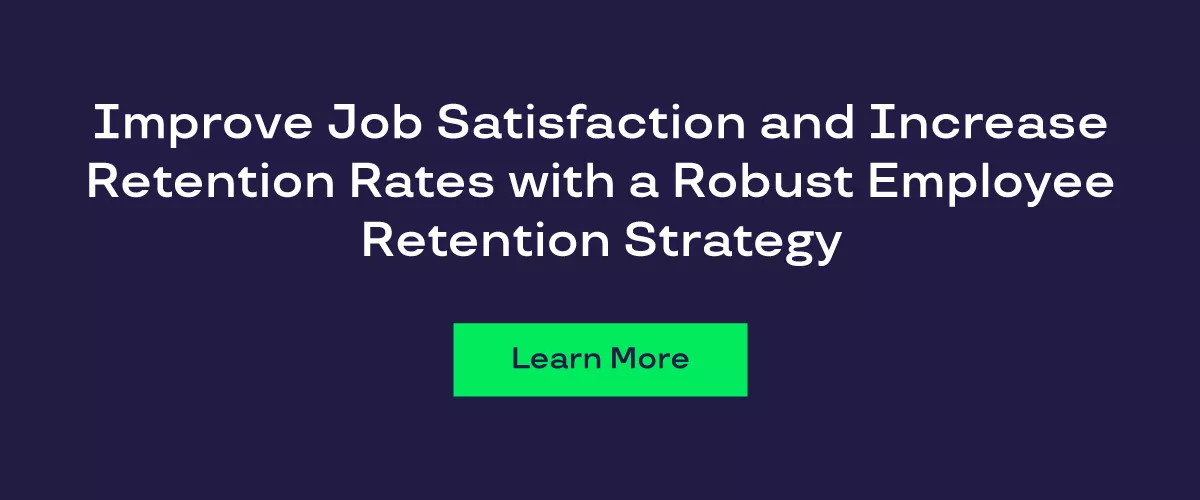
The Ultimate Guide to Effective Employee Retention Strategies
December 11, 2023
Employee retention is a critical concern for organizations no matter the size or industry. High turnover can be costly and disruptive to an organization.
With over 3.6 million employees voluntarily quitting their jobs each month, it’s imperative to understand what strategies you can put into to help retain your best talent.
The question is: how do you keep your employees engaged, motivated, and loyal?
In this article, we'll explore what employee retention is, highlight key workforce statistics you need to know, and discuss some of the most effective employee retention strategies you can implement to retain your top talent.
What is Employee Retention?
Gartner defines employee retention as the “organizational policies and practices that are designed to encourage employees to remain employed by the company.”
Simply put, employee retention refers to the methods and approaches used to retain valuable employees for a long duration within an organization. The benefit of retaining employees is significant, impacting everything from workplace culture to the company’s bottom line.
Employee Retention Statistics Your Should Know
The last few years have been challenging for employees and organizations alike, and today’s workforce is now feeling the impact . Employees are burnt out and stressed at record high levels.
Now, in the face of an economic downturn, many organizations are searching for innovative retention strategies for today's challenges.
To get a better picture of the modern workforce challenges, here are six important employee retention statistics you need to know:
- The Cost of Hiring a Replacement: The Society for Human Resource Management (SHRM) found that on average it can cost a company 6 to 9 months of an employee's salary to replace an employee. For example, to replace an employee that made $60,000 per year, it could cost an organization up to $30,000 - $45,000 in recruiting and training costs.
- Average Tenure of an Employee: The average length of time an employee stays with a company can vary by industry and job role but generally ranges from 3 to 5 years. The U.S. Bureau of Labor Statistics reported the medium employee tenure in 2022 was 4.1 years. Additionally, the report reveals that median employee tenure is higher among older workers than younger workers.
- Employees Open to New Opportunities: 51% of employees across the globe are actively seeking a new job according to Gallup’s 2023 State of the Workplace report.
- Employee Burnout Numbers: Zippia found that 89% of employees have experienced burnout in the last year and 77% of employees have experienced feelings of burnout at their current job. This same study reports that 21% of workers say their company does not offer any program to help alleviate burnout.
- Employee Stress Levels: Employee stress levels have risen to 44% across the globe as reported in Gallup’s report. However, the United States and Canada have the highest level of stress compared to the other regions at 52%, 2 points higher than in 2022.
- Job Satisfaction Levels: Zippia reports that job satisfaction and culture are closely linked with organizational culture impacting job satisfaction by 42%. Additionally, this report reveals that young adults are more likely to be less satisfied by their jobs compared to the older generations.
With over half of the workforce actively seeking a new job and almost 90% of employees recently experiencing burnout, employee retention strategies are imperative for organizational success.
Employee Turnover Rates for Each Industry
A common rule of thumb for employee turnover is that it should be no more than 10%, with employee retention being 90%. However, it is important to note that employee turnover rates do vary widely by industry. To establish a reliable benchmark for comparison, it’s vital to understand what the average turnover rate is for your industry.
As reported by the U.S. Bureau of Labor Statistics, these are the latest turnover rates for each industry:
- Mining and logging: 36.2
- Construction: 56.9
- Manufacturing: 39.9
- Trade, transportation, and utilities: 54.5
- Information: 38.9
- Financial Activities: 28.5
- Professional and business services: 64.2
- Education and health services: 37.3
- Leisure and hospitality: 84.9
- Oher services: 47.2
- Government: 18.1
What are the Most Effective Employee Retention Strategies?
Creating a robust employee retention plan is essential for any organization looking to reduce turnover and maintain a productive workforce. As a recession approaches, many organizations are reassessing their retention strategies to ensure they keep their best – and most knowledgeable – talent onboard.
Here are some of the best employee retention strategies to consider:
1. Meaningful Employee Recognition
Recognizing and appreciating employees' contributions is a powerful retention tool. Acknowledging their hard work and achievements through awards, praise, and incentives can boost morale and job satisfaction.
There are a variety of ways you can implement recognition in your organization, from simple thank you notes to a company-wide recognition platform. A few notable ways are:
- Peer-to-peer recognition platform: A peer-to-peer recognition platform can help cultivate a culture of recognition and appreciation. To amplify the impact on your workforce, you can implement a monetary points-based recognition program that incentivizes recognition.
- Service anniversary rewards: With the average tenure sitting at 4.1 years, celebrating work anniversaries is a great way to drive employee loyalty. Send your employees a thoughtful note and budget-aligned reward on their work anniversary to say thank you for their dedication to your organization.
- Nomination awards: A fun way to foster a culture of recognition and honor your top talent is by implementing a quarterly or yearly nomination award. For example, Inspirus has a yearly Spirit of Inspirus award where employees nominate an employee who they feel best deserves this special recognition.
Tip: The years between the big work anniversary milestones are often times forgotten. To retain your best talent, consider implementing yearly service anniversary rewards. Learn more about budgeting for yearly rewards here.
2. Competitive Compensation
Offering competitive salaries and benefits is crucial for retaining top talent. Employees often consider their compensation package when deciding whether to stay or leave an organization. In fact, Robert Half reports that competitive compensation has the largest influence on job satisfaction for Millennials, Generation X, and Baby Boomers. Moreover, income is the top reason U.S. employees are dissatisfied with their job, as reported by Zippia.
Conduct annual salary benchmarking to ensure your employees’ salaries or hourly wages are aligned with industry standards. Additionally, consider providing annual raises and bonuses for your superstars to show gratitude for their commitment and dedication. These strategies can leave employees feeling valued and fairly compensated, boosting retention rates.
3. Career Development and Growth Opportunities
Providing opportunities for skill development and career growth is a great way to motivate employees to stay. 94% of employees would stay at an organization longer if they offered more career development opportunities as reported by Zavvy.
Show your employees you are invested in their career path within your organization by offering training programs, mentorship, and a clear path for advancement. If employees feel like their company is invested in their career and future, they are more likely to stay longer and perform their best.
4. Work-Life Balance
Supporting a healthy work-life balance is essential, especially for the younger generations. Encourage flexible work arrangements and paid time off (PTO) to help employees manage their personal and professional lives effectively.
Here are a few ways you can support work-life balance:
- Mandate a minimum amount of PTO across the whole organization.
- Offer remote or hybrid work options to promote work flexibility.
- Investigate new technologies that can automate or assist with mundane tasks.
- Support parents by offering childcare assistance benefits.
5. Strong Company Culture
A positive and inclusive company culture can contribute significantly to employee retention. Research shows that a toxic workplace culture can be a main driver of turnover. Foster an environment where employees feel valued, respected, and part of a supportive team.
6. Communication and Feedback
Open and transparent communication is key to improving retention. Regularly solicit feedback from employees and address their concerns promptly to demonstrate that their voices are heard and valued.
Implement an anonymous pulse survey like Employee Voice to understand how employees are feeling in real-time, allowing you to identify underlying problems faster and tailor your employee retention strategies accordingly.
Additionally, you can implement digital employee surveys to gain insight into employee sentiment. A few notable surveys you can use are:
- Cultural Assessment Surveys
- Values Index Surveys
- Remote Working Surveys
- Equality of Voice Surveys
7. Robust Onboarding Program
Many organizations believe that the first 90 days of employment are critical for retaining new hires. Providing a positive onboarding experience during this period can significantly impact long-term retention. Research by Zippia supports this: a good onboarding program can increase new hire retention by 82% and improve their productivity by 70%.
A supportive onboarding program is imperative to an employees’ success and their loyalty to a company. It can have a lasting impression on a new hire and can either set them up for success or drive them away.
Discover how you can set your employees up for success starting on day one here.
8. Work Flexibility
A cost-effective strategy for retaining your employees is offering work flexibility. Robert Half found that Generation Z’ top consideration in a job is workplace flexibility and it’s in the top three for Millennials. Moreover, 32% of employees would take a pay cut to work remotely full time.
Provide employees with the ability to work when and where they want through flexible workplace models such as hybrid and remote.
9. Employee Wellness Benefits
The past few years have been challenging for employees. 89% of employees report having experienced burnout within the past year, and 21% say their organization does not offer programs to help alleviate burnout.
Another study by Aflac reports that nearly 80% of employees state that mental health coverage is critical, yet only 61% have access to mental health care as part of their benefits package.
Organizations can retain their employees by offering employee wellbeing benefits such as access to mental health care providers. Employees will be more inclined to stay at an organization if they feel like their organization is invested in their wellbeing and encourages them to take care of themselves.
10. Commuter Benefits
With the recent surge of return to office mandates, organizations are struggling to motivate and improve morale for their in-office employees. Many employees that enjoyed the freedom and flexibility they had during the pandemic are not eager to give it up.
One great way to ease employees back into the office and reduce turnover is by offering a commuting subsidy that covers employees’ car wear and tear as well as gas costs for commuting.
11. Leadership Development
As the saying goes, “People don’t quit jobs, they quit bad bosses.” Leadership has been proven to have a strong impact on employees’ morale and job satisfaction – and consequently, retention. Joblist’s 2023 United States Job Market Trends Report reveals that 39% of respondents cited their main reason for quitting was bad management or a toxic workplace culture.
To set your people up for success, provide your leaders with the adequate resources and training they need to develop and refine their leadership skills.
12. Team Building Activities
Many organizations are facing the negative repercussions and fallout from mass-layoffs, including poor employee morale and increased stress. Mass-layoffs can cause employees to take on additional responsibilities and feel a lack of job security, drastically impacting stress and burnout levels. This can lead to a decrease in employee job satisfaction and result in employees looking for opportunities elsewhere.
If you are looking for ways to support employees and reduce turnover, consider planning fun team building activities to encourage collaboration and foster team building. A few examples of team building activities you can plan include:
- Employee Handbooks: Facilitate an employee “handbook” workshop where employees detail out their preferred work preferences and fun facts about themselves
- Escape Rooms: If you have a smaller organization, rent out an escape room to encourage team bonds and strengthen collaboration
- Virtual Happy Hour: Host a voluntary virtual happy hour to encourage teams to get to know each other better in an informal setting.
- Baby Photo Quiz: Have employees submit their baby photos and then guess whose baby picture is whose. This is great for smaller team building exercises.
- Recent Highlights Exercise: Encourage your leaders to schedule a meeting where team members can share their recent project and career highlights from the past few months, boosting morale and increasing motivation.
- Would You Rather: If you are looking for an easy and lighthearted team building activity, would you rather is a great choice.
Team building activities are a cost-effective and fun way to boost retention and improve morale. Learn more about how team building can improve employee engagement.
The Secret to High Employee Retention: Employee Engagement
Employee retention and engagement are closely connected. Why? Engaged employees are more likely to stay with an organization, and organizations with high retention rates often have a highly engaged workforce.
When employees are engaged, they feel a strong connection to their organization, find their work purposeful, and are motivated to give their best effort. This intrinsic motivation to excel and contribute positively to the organization not only leads to a more productive workforce but also creates an environment where employees are less inclined to seek opportunities elsewhere. In fact, studies show that a highly engaged employee is 87% less likely to leave their job.
Conversely, low employee engagement can be a significant contributor to turnover. When employees feel disengaged, unappreciated, or undervalued, they are more likely to explore other job opportunities.
Fostering engagement through strategies like open communication, career development, and employee recognition is not only a means to boost overall job satisfaction but also a powerful tool for improving employee retention. In essence, a satisfied and engaged workforce is the cornerstone of a successful employee retention strategy.
The Link Between Employee Retention and Business Results
Employee retention is a fundamental driver of a company's success. Maintaining a stable and motivated workforce can significantly impact the bottom line. When employees are satisfied, empowered, and motivated, an organization benefits:
- Lower Turnover Saves Money: High employee turnover is expensive. According to the Society for Human Resource Management (SHRM), replacing an employee can cost up to 6 to 9 months of their salary. This includes recruitment, onboarding, training, and lost productivity during the transition period. By retaining employees, businesses can avoid these significant costs.
- Enhanced Productivity: High employee retention can have a significant impact on productivity within an organization. Employees that stay with a company for years often develop a deep understanding of the organization’s processes and skills needed for the job, allowing them to be more productive and efficient. Additionally, this institutional knowledge can empower them to provide more innovative solutions to problems.
- Better Customer Satisfaction: Employee retention has proven to be linked to customer satisfaction. Client-facing employees that stay at a company often develop deep relationships customers and have valuable knowledge on the history of the client-relationship and client’s company. When organizations that have a low turnover rate, they typically have a more engaged workforce and are thus more likely to provide excellent customer service. In fact, a study done by Gallup reported highly engaged teams realize a 10% increase in customer loyalty compared to their counterparts.
- Boost in Employee Morale and Job Satisfaction: High turnover can create a negative atmosphere in the workplace. Studies show that there is a correlation between high staff turnover and reduced job satisfaction. The constant comings and goings can lead to lower morale, impacting overall job satisfaction. On the other hand, organizations that focus on retention often have a more positive work culture, fostering a sense of loyalty and camaraderie among employees.
- Competitive Advantage: Companies with low employee turnover often gain a competitive edge over their competitors. They can attract top talent more easily, as prospective employees are drawn to organizations with a good reputation and a strong history of retaining their workforce. A strong employer brand can draw in better talent and a wider pool of applications, which in turn, can lead to improved business performance.
Bottomline, employee retention is imperative for long-term business success. Organizations that prioritize creating a positive, supportive work environment and invest in employee development are likely to see substantial gains in their business outcomes.
Conclusion
A thoughtful, employee-centric approach to employee retention can lead to a more engaged, satisfied, and productive workforce. By adopting these strategies and tailoring to your organization's needs, you will not only boost job satisfaction and retention rates, but also contribute to the overall success of your organization.





